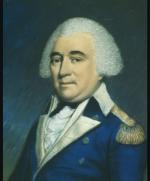![header=[Marker Text] body=[The house in which the Revolutionary leader and Indian fighter was born, Jan. 1, 1745, stands about a mile away. Died at Erie, Dec. 15, 1796; now buried St. David's Church, four and a half miles away. ] sign](kora/files/1/10/1-A-D9-139-ExplorePAHistory-a0a4a6-a_450.gif)
Mouse over for marker text
Name:
Gen. Anthony Wayne
Region:
Philadelphia and its Countryside/Lehigh Valley
County:
Chester
Marker Location:
US 30 at junction PA 252 E of Paoli
Dedication Date:
May 12, 1948
Behind the Marker
Following the Battle at Brandywine, British  General William Howe moved the bulk of his army toward Philadelphia. By the end of September, British encampments were on the outskirts of the city in
General William Howe moved the bulk of his army toward Philadelphia. By the end of September, British encampments were on the outskirts of the city in  Germantown and within the former American capital of Philadelphia itself. The British also maintained a supply camp in Chester County, and sent a contingent of about 3,000 soldiers to return to the Chesapeake Bay to maintain their supply line to New York.
Germantown and within the former American capital of Philadelphia itself. The British also maintained a supply camp in Chester County, and sent a contingent of about 3,000 soldiers to return to the Chesapeake Bay to maintain their supply line to New York.
On September 11, 1777 during the Battle of Brandywine, Wayne and his division of 2,000 Pennsylvania militiamen guarded
Battle of Brandywine, Wayne and his division of 2,000 Pennsylvania militiamen guarded  Chad's Ford, the largest ford on the Brandywine River, from the advancing British. Wayne's division successfully stopped
Chad's Ford, the largest ford on the Brandywine River, from the advancing British. Wayne's division successfully stopped  Wilhelm von Knyphausen from fording the river until late in the battle when the Continentals were forced in retreat.
Wilhelm von Knyphausen from fording the river until late in the battle when the Continentals were forced in retreat.
General Anthony Wayne, a native of Chester County, convinced General George Washington to provide him with a small force to launch an unexpected assault on the Royal supply train near Paoli. Aided by local Tories, however, the British discovered the details of Wayne's plan and devised a stunning counterattack.
Led by General Charles Grey, they crept into Wayne's camp at night with bayonets fixed, surprising the Americans and causing over 400 casualties. A British officer who participated in the assault called it "one of the most dreadful scenes" he had ever encountered. "Every man that fired," he noted, "was instantly put to death." Most American soldiers were unaccustomed to hand-to-hand combat with bayonets and considered the attack barbaric. The "Paoli Massacre" of September 21, 1777 was seared in American public consciousness as evidence of the increasing ferocity of the British effort to subdue the Revolution.
Embarrassed by the outcome of the massacre, Wayne demanded a court-martial that eventually acquitted him of misconduct. He went on to gain fame (notoriety in some eyes) as "Mad Anthony" Wayne, an especially brutal Indian fighter in the 1790s.
On September 11, 1777 during the
General Anthony Wayne, a native of Chester County, convinced General George Washington to provide him with a small force to launch an unexpected assault on the Royal supply train near Paoli. Aided by local Tories, however, the British discovered the details of Wayne's plan and devised a stunning counterattack.
Led by General Charles Grey, they crept into Wayne's camp at night with bayonets fixed, surprising the Americans and causing over 400 casualties. A British officer who participated in the assault called it "one of the most dreadful scenes" he had ever encountered. "Every man that fired," he noted, "was instantly put to death." Most American soldiers were unaccustomed to hand-to-hand combat with bayonets and considered the attack barbaric. The "Paoli Massacre" of September 21, 1777 was seared in American public consciousness as evidence of the increasing ferocity of the British effort to subdue the Revolution.
Embarrassed by the outcome of the massacre, Wayne demanded a court-martial that eventually acquitted him of misconduct. He went on to gain fame (notoriety in some eyes) as "Mad Anthony" Wayne, an especially brutal Indian fighter in the 1790s.






